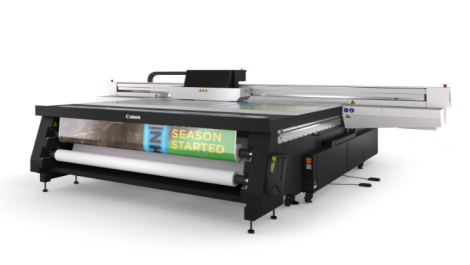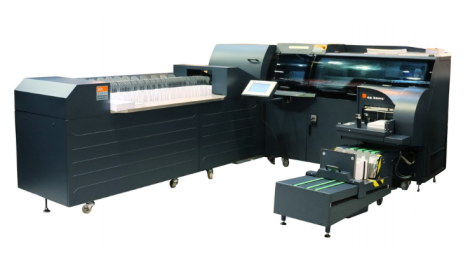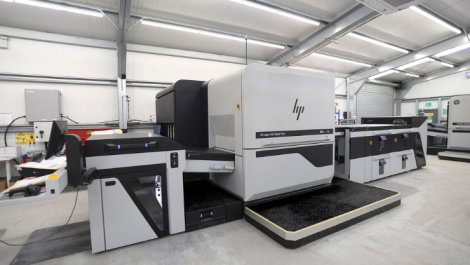Not all inkjets need to be wide ones. Smaller ones can be affordable, compact, versatile and still rake in the dosh. Now there are even desktop eco solvent printer/cutters and miniature UV flatbeds. Nessan Cleary reports.
Wide format printing has seen huge growth in the last ten years with little sign of slowing down. We cover these systems frequently, including in our preview to the Sign & Digital UK show on pages 32 – 34. But here we’re looking at what may seem a contradiction in terms: small wide format inkjets printers. Why should you be considering one?
A the name shows, most wide format inkjets are big, so they need a lot of floor space and you need plenty of work to keep them rolling. This is fine if you’re a dedicated sign and display printer, but there are many types of smaller job that can benefit from the capability of inkjets and their often specialised inks. If you’ve got a wide printer already you’ve always got the option of ganging up several jobs across the width to boost throughput and maximise on the use of media. However if you’re new to the market, or looking to expand into inkjet offerings from an existing ‘narrow format’ commercial print business, you may not want to commit to the cost and space requirements of a big printer right away.
The past couple of years has seen the introduction of a handful of compact printers that use the same solvent based or UV cured printing technologies as conventional wide format models so they’re suitable for similar media, but they cost a lot less and occupy very little floor space – some can just about count as desktop printers.
Two years ago Mimaki introduced a very compact UV flatbed printer, the UJF-3024, with an A3+ printing area and the ability to accept 3D objects up to 50 mm thick. Priced at £22,995 it caused a real stir in the industry and has sold well. It’s a six colour (CMYK+lC+lM plus white) printer. Last year it was revised as the UJF-3024FX, with new LED curing lamps so it can print on heat sensitive media. Resolution ranges from 720 x 600 dpi, at a speed of two and a half minutes for an A3 area, up to 1400 x 1200 dpi, which takes eight minutes for eight passes.
Now the company has announced an improved model, the UJF-3042HG, which can take materials up to 150 mm high. It now has eight ink channels, for six colours plus clear and white inks. White ink circulation has been improved to reduce pigment sedimentation. So far the price hasn’t been announced.
Also new is automatic application of primer via the jetting heads – with the original model the primer had to be applied manually if needed. The primer improves ink adhesion on materials that may not be intended for printing.
There’s a choice of three inksets, including the original LH-100 hard inks, which are still the most popular with customers. Duncan Jefferies, marketing manager at Mimaki’s UK distributor Hybrid Services, says: ‘The majority of the output is to rigid materials, and the hard inks give good scratch resistance and a brighter colour gamut, so most people don’t need the flexible inks.’ The hard inks have the full range with CMYK, white, clear varnish and primer. There’s also a flexible ink, LF-200, that can stretch to 200%, which is useful for vacuum/thermo forming, but there are no white or clear inks with this set. However, a third ink, LF-140, is a good compromise between the two, offering 140% stretchability, with the white and clear inks.
Mr Jefferies says that one of the main applications is branding or personalising finished items such as USB memory sticks, as well as plastic cards and signs. It will even print to moulded items such as golf balls and pens as well as flat objects.
He adds: ‘It’s also used for display graphics or printing images to clear acrylic as an alternative to framing a photograph. It’s also good for small format signage. You can print direct to coloured boards and the opacity of the white will blank out background colours.’ It can be used to build up texture and can even print Braille characters. Mimaki also has the CVJ30 range of solvent print and cut machines for outdoor graphics, and which includes the entry-level CJV30-60, a 610 mm (24 inch) wide model with starting price below £10,000. The choice of inks including the ES3 eco solvents, which include white and metallic, as well as CMYK plus light cyan and light magenta. It uses Epson heads for a maximum resolution of 1440 dpi.
The company also makes a small desktop cutting plotter, the CG60SR/SL series. It’s a 60 cm wide model which runs at up to 50 cm per second. It includes FineCut cutting software and works with both PCs and Macs.
Last year Roland DG introduced the desktop sized VersaStudio BN20 print and cut machine, which really is tiny for an eco-solvent printer, with a footprint of 995 x 585 mm and a weight of 35 kg. It takes roll-fed media up to 515 mm (20 inch) wide, though the maximum cutting width is 480 mm.
At just £5499 it offers an amazingly low cost route into producing small display and signage complete with metallic effects, as well as vinyl labels and lettering. It will also print happily on low cost uncoated papers, which aqueous printers don’t do well. It has a knife head for contour cutting of graphics such as labels and lettering, or just for sheet trimming.
The BN20 is essentially a scaled down version of Roland’s wider VersaCamm VS series. It uses the same Eco-Sol Max low solvent inks, which means they’re low odour, low hazard, and can be used in any reasonably well ventilated room. There’s a choice between a standard CMYK version or a five colour model using CMYK plus a metallic silver ink that can be used with the other colours to create a range of tints. Sadly there’s no white ink with this model. The four-colour version can also use Roland’s aqueous pigment inks. Epson printheads give a maximum resolution of 1440 dpi, so the image quality is much the same as the familiar aqueous proofers.
Roland DG’s product manager Matt Drake says it’s suitable for a number of applications: ‘Because it supports the metallic colours its perfect for label printing. The other market is copy shops and commercial printers that want to make the move to outdoor durable graphics.’
Mr Drake says that it’s also suitable for the garment market as it can print direct to textiles. However, anecdotal evidence suggests that the metallic inks tend to sit on top of the material, rather than penetrating into the fibres so that they tend to wash off during laundering. This may not be an issue for some short-term promotional tee shirts or for soft signage.
Roland also has a flatbed UV printer, the VersaUV LEF-12, which can print to flat and 3D objects up to 100 mm thick and 280 x 305 mm. It uses both Roland’s Eco-UV and its more flexible counterpart Eco-UV S inks. It uses CMYK plus white and clear varnish and can achieve both a matte and high gloss finish. The price is around £22,000, which may hold it back: it is much the same as Mimaki’s compact flatbed, which offers double the printing area. However, the Roland is physically much smaller and lighter, which some users may appreciate: it’s 335 x 310 x 100 mm (L x W x H) and weighs just 5 kg so it’s a true desktop printer.
Aqueous ink printers
Smaller format inkjets in the 17 and 24 inch width league have been widely used as proof printers for commercial offset printers since the 1990s. The dominant players are Canon, Epson and HP. These use aqueous inks and precision droplet control to give spectacular quality at the expense of relatively low speeds. Entry costs are typically lower than solvent or eco solvent models for a given width, though aqueous ink tends to be more expensive. The inks are non-hazardous, without the odour of solvent inks, and if protected the prints are fade resistant for more than 100 years.
Many users have found that they can use aqueous printers to expand out of proofing into ‘print for pay’ work for professional photography, fine art and indoor display and point of presence (PoP) work. A growing use for them is to print wraparound covers for landscape format A4 and even A3 short run books, as you can’t get the right size out of most sheetfed digital presses.
However, being water based, the inks only really work with specially coated papers. They can’t bond with the plastic media used for outdoor banners and signage and they wouldn’t be sun and weatherproof even if they did. For durable work on plastics you need either a solvent based ink that partly dissolves the surface of the plastic and combines with it, or an ultra violet light cured ink that basically sticks to practically anything and then instantly sets.
Epson sells a wide range of large aqueous printers from small A3+ models for home photographers up to 66 and 66 inch wide models for display graphics. Three approximately A2 format models in our compact category would be particularly suitable for print-for-pay work, the Stylus Pro 3880, 4880 and 4900. Of these, the 3880 is really aimed at the photography and fine art markets. It’s a compact desktop model with input and output trays that fold away when not needed. It only takes cut sheet media but this is a positive advantage in some cases, as it means the prints are always flat – with roll fed printers there can be a curl to the prints as the end of the roll is approached. This model also has a straight-through feed slot for thicker card media.
It uses the UltraChrome K3 with vivid magenta inkset for a respectably wide gamut. This includes nine colours, though only eight are used at any one time because there’s a choice of two blacks for gloss or matt papers.
The bulkier roll fed 4000 series printers are scaled down 17 inch (432 mm) wide versions of Epson’s larger wide format printers and have gained an good reputation over the years as proofing devices.
Rolls are fed from the rear, but there’s a retractable tray at the front for sheets up to A2 format. The odd width means that they can’t quite act as B2 proofers, so B2 offset printers will usually choose the 24 inch 7000 series Epsons, though these are substantially larger and heavier. The current SP 4880 uses the same UltraChrome K3 ink as the 3880. Its maximum resolution is 2880 x 1440 dpi. The Stylus Pro 4900 is a brand new machine as Epson had to redesign the basic chassis to accommodate the newer generation TFP print heads and the new UltraChrome HDR inkset with its 11 inks.
Product manager Martin Johns says: ‘The paper handling has been much improved and the TFP printheads have added twice the nozzles, up from 180 to 360 per colour so double the speed.’ Resolution remains the same at 2880 x 1440 dpi. There’s an optional in-line SpectroProofer for calibrating the colour output and creating ICC profiles for different media. It has a production speed of 30 m2 per hour. Epson sells the 4900 for £2154, though you can find it online for quite a bit less.
Canon makes the ImagePrograf iPF5100, a 17 inch wide printer aimed mainly at photo and proofing markets. It takes media up to 432 mm wide, both roll fed and cut sheet. This is simply a smaller version of its larger wide format machines, with exactly the same imaging technology that’s also available in its 24, 44 and 60 inch models.
The iPF5100 uses the 12-colour Lucia II inkset, which Canon claims is more cost effective because there’s less need to blend inks to produce the right colours, as well as producing a very wide colour gamut.
Maximum resolution is 2400 x 1200 dpi with 4 picolitre ink droplets, able to print a standard quality image on A2 photo glossy paper in just over two minutes.
HP doesn’t bother with professional printers in the 17/18 inch range but has a number of 24 inch printers. Perhaps the most interesting is the 610 mm wide DesignJet Z3200, which is aimed firmly at the photo market. It uses water-based pigment inks, having a 12-colour inkset which includes a chromatic red ink (that replaced the original, criticised red of the Z3100) plus a gloss enhancer. It takes roll-fed and sheet media up to 500 g/m2. It has an embedded X-Rite i1 spectrophotometer which can generate ICC calibration profiles.
If you’re looking to dip your toe in the ‘large format’ market but don’t have the space or the budget for a truly wide machine, any of these machines can set you on the path to new sales opportunities, with the same quality and media flexibility as their larger brethren, but at a fraction of the price.




